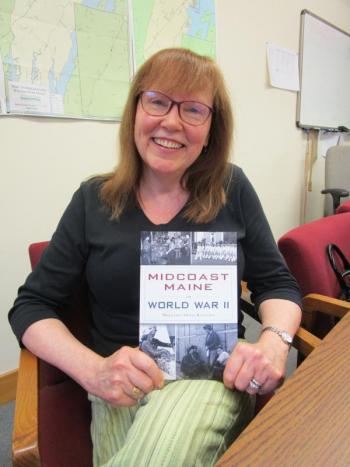When Maine’s Midcoast answered the call
What life was like on the homefront is the subject of a new book titled, “Midcoast Maine in World War II” researched and authored by Peggy Shiels Konitzky.
Konitzy and husband Gus live in Topsham. She is a familiar face in the Wiscasset area, where she serves as site manager for both Castle Tucker on High Street and the Nickel-Sortwell House on the corner of Main and Federal streets. She was also associated with the community’s popular Museum in the Streets project.
The paperback book was recently published by The History Press of Charleston, SC. It includes 14 chapters each covering in colorful detail what life was like for Midcoast Maine families during WWII. Konitzky chronicles the lives of everyday folks who “kept the home fire burning” while others went off to fight for America’s freedom.
Konitzky spent two years researching her book including interviews of residents who lived through these epic times. She spent many hours perusing newspaper archives of the Boothbay Register, Lincoln County News, Bath Times and Brunswick Record reading wartime stories and editorials.
Headlines like “Community Calm in War – Citizens Resolve to Do All in Their Power to Help” speak volumes about what times were like then.
Among the people Konitzky interviewed were Calvin and Marjorie Dodge of Newcastle, William and Judith Sutter of Wiscasset, the late Joan Leslie of Wiscasset, Robert Brochard of St. John’s Church in Brunswick and local author-historian Barbara Rumsey of Boothbay. All had stories to share, and letters and memorabilia helpful to Konitzky in compiling her book.
The chapters explore the day-to-day challenges faced by ordinary Mainers who met these wartime challenges by doing extraordinary things.
As Konitzky explains, mothers, for instance had to cope with their husband or sons going off to war leaving them the task of managing the household and often working a job. Along with balancing these responsibilities, women nonetheless found time to volunteer at the Red Cross or USO.
In the chapter titled, “Scrimp, Salvage and Save, ” Konitzy tells how people helped with the war effort. Along with buying War Bonds, citizens organized drives for collecting rubber and metal needed for the armed forces. One picture shows a truck loaded down with a small mountain of scrap metal and tires collected in the Boothbay area by Donald Giles, Glidden Rines and two other local men.
She notes a Labor Day scrap rally on the Brunswick Mall included an inspiring patriotic speech by Wiscasset’s Bradford C. Redonnett, a well-known lawyer and schoolteacher.
Konitzky said residents of all ages had to deal with mandatory rationing. WWII caused shortages of everyday things like tin, rubber, gasoline – even clothing. Other shortages included food staples Americans take for granted today like coffee and sugar.
In “The Ration Blues,” Konitzky tells of the first U.S Government Ration Books that were issued in May 1942.
“The ration stamps inside (sometimes called coupons) enabled the book-holder to purchase one pound of sugar per stamp within a specified two-week period indicated by the number on the stamp,” she explains. “Each book had 28 stamps that were suppose to last 56 weeks.”
Other chapters cover men and women who volunteered for the Home Guard in units like the Coastal Beach Patrol and Civil Air Patrol.
Illustrations include reproductions of posters promoting the war effort and an impressive collection of local wartime pictures. Several are of women at Bath Iron Works performing jobs usually held down by men at the shipyard.
The appendix includes names of those who took part in Civil Defense, served as Air Raid Wardens, Air Craft Spotters and USO volunteers. There’s also a helpful bibliography and index.
Konitzky is a graduate of Georgetown University School of Foreign Service and earned a master's of business administration from New York University’s Stern School of Business. Later she earned a museum studies certificate from Tufts University.
Konitzky said she’s received a warm reception for her work she calls a labor of love. Maine Antiques Digest gave it a very positive review. To help promote her book, she’s planning lectures and book signings. One will be on Aug. 8 at the Bristol Library.
People can purchase “Midcoast Maine in World War II” at Ames True Value in Wiscasset, Sherman’s Maine Coast Book Shop in Damariscotta, through Amazon Books or directly from Konitzky at pkonitzy@comcast.net































